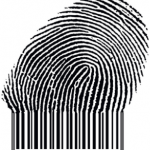Biometric Identity Theft: Stolen Fingerprints
Identity Theft is a huge and growing problem. According to the recent 2009 Identity Theft Fraud report by Javelin Strategy & Research, victims increased 22% in 2008 to 9.9 million. When businesses are involved, the companies face billions of dollars in theft, millions of dollars in fines and, perhaps most important, the loss of customer trust.
The large impact that identity theft has on individuals lives and corporations’ bottom lines has made inexpensive biometrics look attractive for authenticating employees, customers, citizens, students and any other people we want to recognize. The most recent debate is on whether the pros outweigh the cons. (To see some of the materials that influenced this article, please visit George Tillmann’s excellent article in Computerworld).
 Biometrics uses physical characteristics, such as fingerprints, DNA, or retinal patterns to positively verify individuals. These biological identifiers are electronically converted to a string of ones and zeros and stored on file in the authenticator database.
Biometrics uses physical characteristics, such as fingerprints, DNA, or retinal patterns to positively verify individuals. These biological identifiers are electronically converted to a string of ones and zeros and stored on file in the authenticator database.








